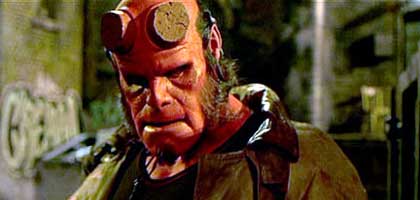
Beauty in the beast
Film of the Month: Hellboy

A film of Hellboy comic has more than its share of fights and monsters. But it brings the character to life with a big red heart, says Kim Newman.
Few comic-book franchises have been brought to the screen by a creator as committed to honouring the original material as Mike Mignola's Hellboy, a project nurtured over several years by Guillermo del Toro. The writer-director's love of arcane mechanics laced with bug imagery makes him perfectly attuned to the world of Mignola, an artist whose major cinema presence to date was as a source for the Jules Verne-styled 'steampunk' design of Disney's 2001 Atlantis The Lost Empire. The bio-mechanical intricacy that has been a del Toro touchstone since the insect-and-clockwork device at the heart of Cronos (1993) is central to Hellboy on the page and on screen, where the devices are bigger -using grinding stone and creaking iron -but as visually delightful.
Hellboy the character has been around for over a decade, appearing first in one-off stories before receiving a proper introduction in the mini-series Hellboy: Seed of Destruction (the source for del Toro's screenplay); rather than being published continuously, the Hellboy comic has been issued in limited series subsequently repackaged as books. Though a few other artists have been allowed to draw the character and Seed was scripted by John Byrne, Hellboy remains essentially Mignola's property, ensuring a visual consistency in the character's presentation along with a gradual revealing of the world in which he lives.
A tall, bulky, red figure with a prehensile tail and bumps on his forehead where he sawed off his demon horns ("to fit in"), Hellboy is one of comics' big kids in non-human bodies (like the Thing, the Hulk or Swamp Thing). He's living proof of the nurture-over-nature theory in that despite his demonic origins, his all-American upbringing has led him to feel like a real boy and act like a regular, grouchy, cigar-chomping action man. The key moment in the comic, reproduced perfectly here, comes after Hellboy has been snatched from the Nazis who would raise him as an Antichrist: the demon baby poses for a photograph with a crowd of smiling World War II-era GIs and the academic foster father who will raise him to live like these regular-Joe heroes.
A 60-year-old adolescent, Hellboy consumes large quantities of pancakes, beer and Baby Ruth bars then faces up to ultimate evils with a comically big gun and an even bigger (though less comical) stone hand. Ron Perlman, often seen under make-up since his debut in Quest for Fire (1981) and a del Toro regular since Cronos, seemed to have found the role of a lifetime in the television series Beauty and the Beast but trumps that lovelorn hero-monster part here. His fed-up-hero mannerisms, nervy crush on Liz and solid presence in the many, many deathtrap scenes bulk out the comic-book character.
The first problem any Hellboy film has to overcome is presenting the big red hunk as a believable part of the real world, and here del Toro goes against the prevailing wisdom (cf: Hulk) that such characters can be realised only with CGI. Though perspective tricks are used to make the full-grown Hellboy tower over regular humans, he is almost entirely a physical presence -first found in a lair surrounded by pussycats and food, with the rasping sound of Tom Waits' 'Heart Attack and Vine' mixed in as a character touchstone. Of course Hellboy is superb in the several action scenes, and we get as many locations for skirmishes as levels in a videogame: a museum of antiquities, a funfair at Halloween, the New York subway and an impressive world of traps and dungeons under Rasputin's supposed tomb outside Moscow. But it's to Perlman's credit that Hellboy works as well in the wry comedy moments and the temptation sequence when his horns regrow (with a flaming crown floating between them) and he has a vision of the position he might hold as a master of a ravaged world.
Having tackled a comics project in 2002's Blade II (with Perlman in a supporting role), undertaken as a demo piece to prove he could make this, del Toro still doesn't quite deliver a script that contains all the comic's great material. The device of using Rupert Evans' Agent Myers (new-minted for the film) as a way into the world of the Bureau of Paranormal Research and Defence (BPRD) and the trigger for an understated love triangle makes some sense, but the long prologue means our viewpoint character doesn't turn up until the mood is already established. Myers is a lot less fun than anyone else in the room (including John William Johnson as the agent he is supposed to be replacing) and is swiftly reduced to a tag-along character with only a few more lines than the Star Trek-style 'red shirts' who are taken into the catacombs to be killed off by deathtraps the higher-billed heroes then cope with.
John Hurt narrates the set-up and has a dignified extended cameo as Bruttenholm (the film doesn't quite understand that 'Broom' is how the name is pronounced, not a separate nickname). Unfortunately, the spiky, indulgent, affectionate but troubled relationship between Hellboy and this human father is given less weight than the hero's more conventional love for Liz. In a brilliant move, Bruttenholm's death not only spurs the emotional climax but makes room for another welcome player in Jeffrey Tambor's officious, wry BPRD commander -who finally bonds with Hellboy by showing him how to light his cigar properly.
The bad guys have great looks, but the conflicted hero shoulders the complexity. Karel Roden's bald, glowering Rasputin -Hellboy's putative mentor who has survived his historical death -is a plot function rather than a person, though he arises magnificently from a pool of blood at the centre of a mandala carved into a temple floor outlined by the spilled gore of a sacrificial guide. The CGI-tentacled entities he brings into the world encourage messy action along the lines of the Blade films; a subway chase echoes one in Stephen Norrington's original Blade; and the big-monster finish seems a polished version of the climax abandoned for that film but included on the DVD. The best of the villains is mime artist Ladislav Beran as Hitler's surgery-addicted assassin Kroenen: a lipless, eyelidless mummy seen in a disturbing gas mask and/or full SS regalia. Like the sensitive Black Lagoon-style creature Abe Sapien (swum by Doug Jones and voiced by David Hyde Pierce), Kroenen is a sinuous, prissy, almost effeminate presence beside the thumping Hellboy and has an elegant human cruelty that makes his final confrontation with the hero more satisfying than yet another squid-squashing effect. It may offer a big battle too many, but Hellboy succeeds because it brings the visuals from the page to life with a beating red heart.
